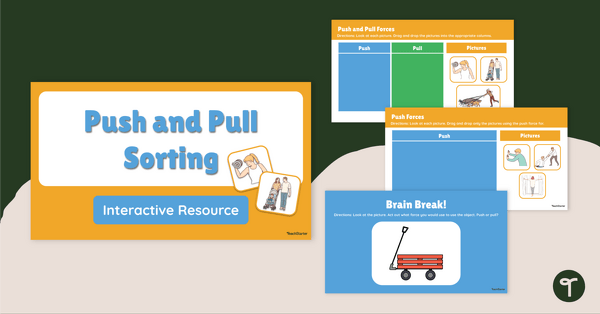Use these forces and motion scavenger hunt worksheets when exploring push and pull forces in your early years science lessons.
A Forces and Motion Scavenger Hunt for the Early Years
Are you looking to actively engage your students in their learning? Keen to promote a little friendly competition in your classroom? Look no further than Teach Starter’s forces and motion scavenger hunt!
This force and motion scavenger hunt has been designed by our experienced teacher team to inspire your students to find objects that can be pushed and pulled in their immediate environment. This task is a fantastic way to make learning about forces fun and interactive. Students will embark on an adventure to discover, observe and draw objects that can be pushed or pulled. It’s a delightful journey where learning happens while having a great time!
Four different versions of this force and motion scavenger hunt have been provided. The slightly different variations in these activities have been outlined below:
- Push and Pull Forces Scavenger Hunt (1) – Students must find and draw two objects for each force, then two examples of objects that can be both pushed and pulled.
- Push and Pull Forces Scavenger Hunt (2) – Students must find and draw three objects for each force, then three examples of objects that can be both pushed and pulled.
- Push Force Scavenger Hunt – Students must find and draw six examples of objects that use a push force only.
- Pull Force Scavenger Hunt – Students must find and draw six examples of objects that use a pull force only.
This resource is available as a black-and-white PDF or an editable Google Slides file (should you wish the students to complete the task digitally).
This hands-on activity is bound to spark your students’ curiosity, promote exploration and friendly competition, and deepen your students’ understanding of forces in motion.
How to Use This Forces and Motion Scavenger Hunt
There are multiple options when it comes to implementing this forces and motion scavenger hunt into your science lessons. If you’re in need of some inspiration, check out these suggestions:
- Independent Exploration – Distribute the scavenger hunt worksheets to your students and let them explore their surroundings. They’ll identify objects that can be pushed or pulled, draw what they find, and share their discoveries with the class.
- Collaborative Scavenger Hunt – Organise a classroom scavenger hunt where students work in pairs or small groups. You might even like to send groups of students to different areas of the school to see what kinds of push and pull objects they can find!
- Interactive Discussion – After completing the forces and motion scavenger hunt, engage your students in a group discussion. Encourage them to explain their findings and share their observations with the class. This is a great way to reinforce their understanding of push and pull forces.
Download to Start Scavenging!
This forces and motion scavenger hunt downloads as an easy-print PDF or an editable Google Slides. Use the download button to access your preferred file format. (Note: You will be prompted to make a copy of the Google Slides template on your personal drive before accessing it.)
If you intend to use all the worksheets, please consider printing these double-sided – the environment will thank you for it!
This resource was created by Lisamarie Del Valle, a Teach Starter collaborator.
More Pushing and Pulling Resources to Save You Time!
Cut down on your science planning by downloading more of Teach Starter’s push and pull resources for early years students. We promise you won’t be sorry you did!

teaching resource
Pushes and Pulls Mini-Book
Explore pushes and pulls with your students with this printable mini-book perfect for early years science lessons.

teaching resource
Push and Pull Examples – Matching Game
Have students explore examples of push and pull forces with this matching game to use during your forces and motion science unit.

teaching resource
Push or Pull? Interactive Sorting Activity
Explore push and pull forces with your students by playing this interactive sorting game for lower primary students.












0 Comments
Write a review to help other teachers and parents like yourself. If you'd like to request a change to this resource, or report an error, select the corresponding tab above.